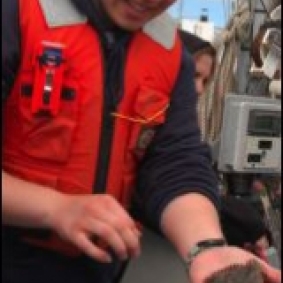Eight students will be presenting the summer work at the Ocean Sciences Meeting in March 2022!
Jacqueline Walters, State University of New York at Geneseo
Class Year:
2005Mentor:
Carys Mitchelmore, Ph.D.Project Title:
Assessing the Acute Toxicity of Oil and Dispersed Oil to the Symbiotic Sea Anemone Anthopleura elegantissima
Abstract:
Cnidarian-algal symbioses exist as a sensitive balance between the two partners. This symbiosis may be disrupted upon exposure to stressors including organic contaminants such as crude oil. Symbiosis breakdown can lead to algal cell loss i.e. bleaching which may result in death of the species. This is particularly problematic in tropical regions where corals form the trophic and structural foundation of the ecosystem. Following an oil spill responders must decide upon the appropriate action, often leading to trade off decisions regarding different species and habitats. Therefore, using chemical dispersants would protect mangroves but potentially impact the sub-tidal coral reefs that previously would have received little or no impact from an overlying spill. Therefore, these decisions must be made using sound scientific data. We used the temperate sea anemone Anthopleura elegantissima as a model of this sensitive cnidarian-algal symbiosis. Anemones were exposed to realistic short-term (8 hour) acute doses of various dilutions of water accommodated fractions (WAF) and chemically enhanced WAF (CEWAF) of weathered Arabian Light crude oil using standard CROSERF techniques. Injury was determined using a multi-tiered approach employing an array of metrics from acute endpoints (e.g. mortality) to behavioral and biochemical assays. Mortality was not observed even at the highest dose (100% stock solution, using 25g oil / L water) after 8 hours of exposure in either the WAF or CEWAF exposures. However, tentacle and column expansions were significantly reduced in the higher CEWAF (not WAF) exposures. In addition visual and quantified production of mucus increased with dose, particularly in the CEWAF exposures. Further analyses of water chemistry (for determination of PAH and TPH levels) and molecular endpoints are underway. This work has provided the information required to base a detailed long-term anemone exposure on and will assess the sensitivity of this species to crude oil and whether it serves as a good model of cnidarian-algal symbiosis.
Location:
Chesapeake Biological LaboratoryPresentations:
Walters, J.*, and C. Mitchelmore. 2006. Assessing the acute and sublethal effects of oil and dispersed oil sensitive Cnidarian-algal symbiosis . ASLO Ocean Sciences Meeting, Honolulu, Hawaii .




